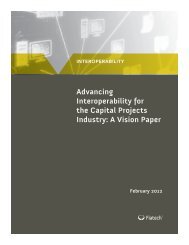An Introduction to ISO 15926 November 2011 - iRINGToday
An Introduction to ISO 15926 November 2011 - iRINGToday
An Introduction to ISO 15926 November 2011 - iRINGToday
Create successful ePaper yourself
Turn your PDF publications into a flip-book with our unique Google optimized e-Paper software.
CHAPTER 1:<br />
WHY WE NEED <strong>ISO</strong> <strong>15926</strong><br />
It is difficult <strong>to</strong> overestimate the value of being able <strong>to</strong> exchange information with anyone<br />
without fear of transcription error, while maintaining the precise meanings of all terms, even<br />
though you know nothing at all about your partner’s internal work processes and methods of<br />
data s<strong>to</strong>rage. When information is transferred correctly, the quality and reliability of your end<br />
product increases. When you know for sure that information will be transferred correctly, you<br />
can move faster because you do not have <strong>to</strong> check for transcription errors.<br />
A significant part of designing, building, and operating capital assets involves transferring and<br />
accessing information about those assets. In its oft-cited 2004 report Cost <strong>An</strong>alysis of Inadequate<br />
Interoperability in the U.S. Capital Facilities Industry, the National Institute of Standards<br />
and Technology (NIST) reported claims of some companies that 40 percent of engineering<br />
time was spent finding and verifying information. Overall, the study showed that the lack of<br />
interoperability among computer-aided design (CAD), engineering, and other software systems<br />
costs the American capital projects industry more than $15 billion every year. 1<br />
<strong>ISO</strong> <strong>15926</strong> makes exchanging information between applications easier in two ways. First, when<br />
your information exchanges go beyond manually rekeying data or using point-<strong>to</strong>-point cus<strong>to</strong>m<br />
mapping (which we discuss shortly) you need <strong>to</strong> create some type of data dictionary containing<br />
definitions of all objects in your facility—along with their attributes. If your organization is<br />
sufficiently large, this requires a significant effort. Instead of developing your own dictionary,<br />
<strong>ISO</strong> <strong>15926</strong> offers a dictionary 2 that you can use free of charge. Because the <strong>ISO</strong> <strong>15926</strong> dictionary<br />
has been developed by a great number of people from many industries in many parts of<br />
the world, there is a high probability that the definitions you need are already there.<br />
Second, when we exchange information <strong>to</strong>day we need people <strong>to</strong> manage the transactions<br />
because we mistakenly assume a consistently applied background of rules and jargon of the<br />
trade. We call these background rules “context,” and without context we are lost. We need <strong>to</strong><br />
be able <strong>to</strong> apply these rules consistently in order <strong>to</strong> correctly match terminology in a universe<br />
of very similar terms.<br />
If we use the full specification of <strong>ISO</strong> <strong>15926</strong>, we can make information exchanges easier by<br />
essentially building the context of the information in<strong>to</strong> the information itself. When we model<br />
the information, we can capture the precise meaning of each term and embed it with the<br />
term. This makes it easier for machines <strong>to</strong> talk directly <strong>to</strong> each other because implied meanings<br />
that participants are “just expected <strong>to</strong> know” are eliminated (or at least minimized).<br />
These two issues are intertwined. To fully understand the value of simply being able <strong>to</strong> use an<br />
existing data dictionary, instead of having <strong>to</strong> develop one from scratch, we will first discuss<br />
the sources of information exchange costs. This will leads <strong>to</strong> a discussion of “context” and<br />
1. The report is available online. Search for “Cost <strong>An</strong>alysis of Inadequate Interoperability in the U.S.<br />
Capital Facilities Industry.”<br />
2. Truth in advertising: Data exchange in the manner envisioned by <strong>ISO</strong> <strong>15926</strong> requires more than just<br />
a dictionary. We are simply starting with a description of how the dictionary component works as a<br />
way of easing in<strong>to</strong> the <strong>to</strong>pic.<br />
CHAPTER 1<br />
12



